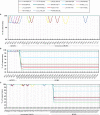Highly conserved cross-reactive CD4+ T-cell HA-epitopes of seasonal and the 2009 pandemic influenza viruses
- PMID: 20716156
- PMCID: PMC4634651
- DOI: 10.1111/j.1750-2659.2010.00161.x
Highly conserved cross-reactive CD4+ T-cell HA-epitopes of seasonal and the 2009 pandemic influenza viruses
Abstract
Background: The relatively mild nature of the 2009 influenza pandemic (nH1N1) highlights the overriding importance of pre-existing immune memory. The absence of cross-reactive antibodies to nH1N1 in most individuals suggests that such attenuation may be attributed to pre-existing cellular immune responses to epitopes shared between nH1N1 virus and previously circulating strains of inter-pandemic influenza A viruses.
Results: We sought to identify potential CD4+ T cell epitopes and predict the level of cross-reactivity of responding T cells. By performing large-scale major histocompatibility complex II analyses on Hemagglutinin (HA) proteins, we investigated the degree of T-cell cross-reactivity between seasonal influenza A (sH1N1, H3N2) from 1968 to 2009 and nH1N1 strains. Each epitope was examined against all the protein sequences that correspond to sH1N1, H3N2, and nH1N1. T-cell cross-reactivity was estimated to be 52%, and maximum conservancy was found between sH1N1 and nH1N1 with a significant correlation (P < 0.05).
Conclusions: Given the importance of cellular responses in kinetics of influenza infection in humans, our findings underscore the role of T-cell assays for understanding the inter-pandemic variability in severity and for planning treatment methods for emerging influenza viruses.
Figures


Similar articles
-
A human CD4+ T cell epitope in the influenza hemagglutinin is cross-reactive to influenza A virus subtypes and to influenza B virus.J Virol. 2012 Sep;86(17):9233-43. doi: 10.1128/JVI.06325-11. Epub 2012 Jun 20. J Virol. 2012. PMID: 22718815 Free PMC article.
-
Potential T cell epitopes within swine-origin triple reassortant influenza A (H3N2) variant virus which emerged in 2011: an immunoinformatics study.Vaccine. 2012 Sep 14;30(42):6054-63. doi: 10.1016/j.vaccine.2012.07.054. Epub 2012 Aug 8. Vaccine. 2012. PMID: 22877860
-
Universal H1N1 influenza vaccine development: identification of consensus class II hemagglutinin and neuraminidase epitopes derived from strains circulating between 1980 and 2011.Hum Vaccin Immunother. 2013 Jul;9(7):1598-607. doi: 10.4161/hv.25598. Epub 2013 Jul 11. Hum Vaccin Immunother. 2013. PMID: 23846304
-
Recalling the Future: Immunological Memory Toward Unpredictable Influenza Viruses.Front Immunol. 2019 Jul 2;10:1400. doi: 10.3389/fimmu.2019.01400. eCollection 2019. Front Immunol. 2019. PMID: 31312199 Free PMC article. Review.
-
Cross-reactive human B cell and T cell epitopes between influenza A and B viruses.Virol J. 2013 Jul 26;10:244. doi: 10.1186/1743-422X-10-244. Virol J. 2013. PMID: 23886073 Free PMC article. Review.
Cited by
-
Influenza pandemic waves under various mitigation strategies with 2009 H1N1 as a case study.PLoS One. 2010 Dec 20;5(12):e14307. doi: 10.1371/journal.pone.0014307. PLoS One. 2010. PMID: 21187938 Free PMC article.
-
Highly conserved antigenic epitope regions of hemagglutinin and neuraminidase genes between 2009 H1N1 and seasonal H1N1 influenza: vaccine considerations.J Transl Med. 2013 Feb 22;11:47. doi: 10.1186/1479-5876-11-47. J Transl Med. 2013. PMID: 23433453 Free PMC article.
-
Peptide Epitope Hot Spots of CD4 T Cell Recognition Within Influenza Hemagglutinin During the Primary Response to Infection.Pathogens. 2019 Nov 5;8(4):220. doi: 10.3390/pathogens8040220. Pathogens. 2019. PMID: 31694141 Free PMC article.
-
The establishment of surrogates and correlates of protection: Useful tools for the licensure of effective influenza vaccines?Hum Vaccin Immunother. 2018 Mar 4;14(3):647-656. doi: 10.1080/21645515.2017.1413518. Epub 2018 Jan 16. Hum Vaccin Immunother. 2018. PMID: 29252098 Free PMC article. Review.
-
A human CD4+ T cell epitope in the influenza hemagglutinin is cross-reactive to influenza A virus subtypes and to influenza B virus.J Virol. 2012 Sep;86(17):9233-43. doi: 10.1128/JVI.06325-11. Epub 2012 Jun 20. J Virol. 2012. PMID: 22718815 Free PMC article.
References
-
- Chan M. World now at start of 2009 influenza pandemic: statement to the press by WHO director‐general, on 11 Jun 2009. http://www.who.int/mediacentre/news/statements/2009/h1n1_pandemic_phase6.... Accessed 01 January 2010.
-
- Tuite AR, Greer AL, Whelan M et al. Estimated epidemiologic parameters and morbidity associated with pandemic H1N1 influenza. CMAJ. 2009; 182(2):131–136. DOI:10.1503/cmaj.091807. - DOI - PMC - PubMed
Publication types
MeSH terms
Substances
Grants and funding
LinkOut - more resources
Full Text Sources
Research Materials

